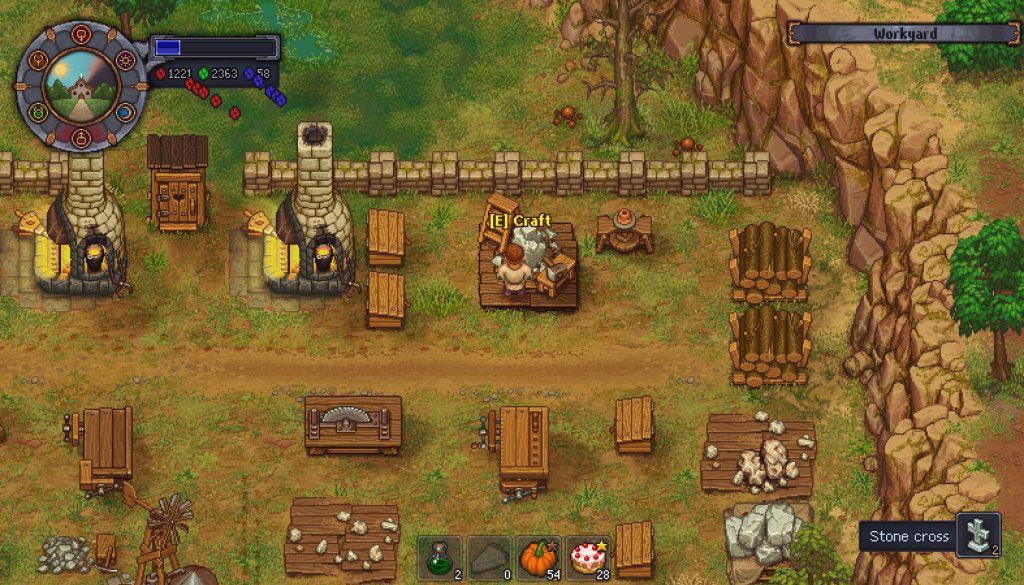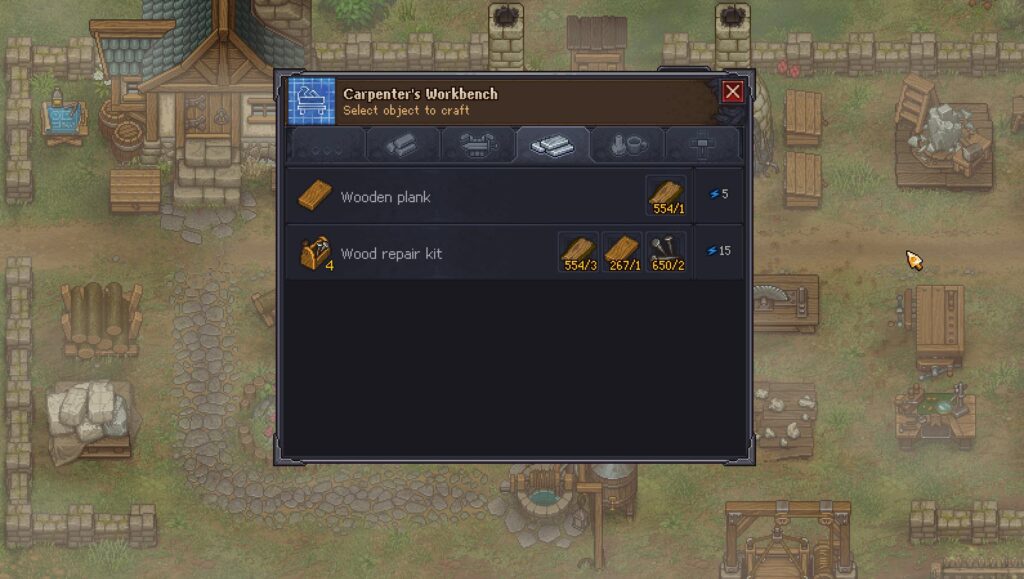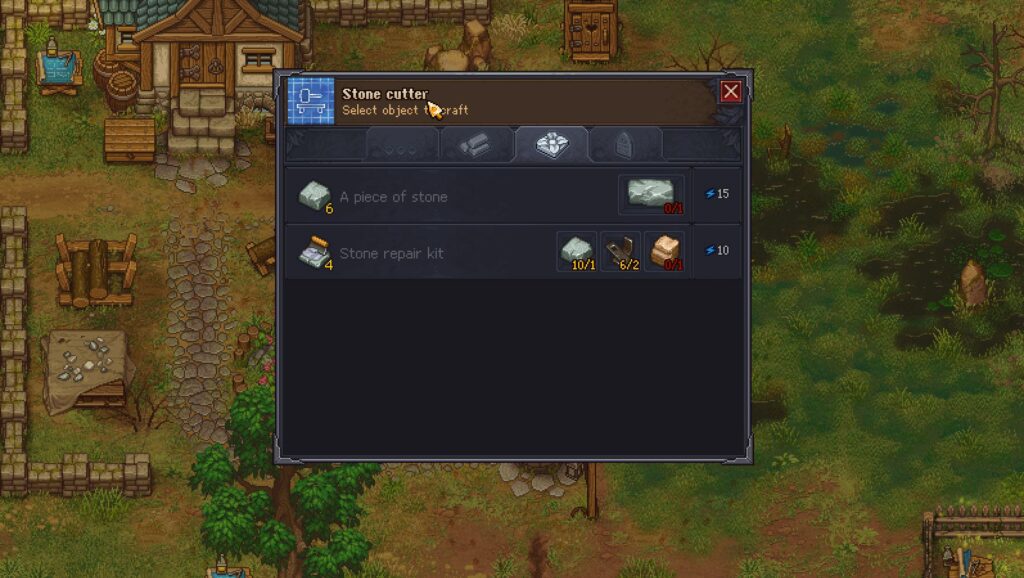Graveyard Keeper is one of the better cozy games out there, combining a surprisingly dark sense of humor with fun and unique mechanics not seen in most farm sims, an incredible soundtrack, great unique art, a Communist Donkey, a talking Skull, er…well it’s unique. We’ll just put it that way. There’s a reason the game is so popular, but the question is how do you get those all-important restoration tools in Graveyard Keeper’s early game?
While the Tech tree can be a bit complicated the first go round, the good news is that the game is also designed to be fairly intuitive where the need for one tech leads to another, which leads to needing nails which leads to that tech, and so on.
By following the various branches of the tech tree you can get to restoration tools early in the game.
There are actually 3 types of restoration tools in Graveyard Keeper, and those are:
- Wood Repair Kits
- Stone Restoration Kits
- Marble Restoration Kits
The first two of these are pretty easy to unlock and you can have them in your very first in-game week (though it takes until week 2 to be able to actually use stone restoration kits). The Marble Restoration Kits take a bit more, but you won’t need them for some time so most players don’t stress on those.
It’s not being able to produce the first two that can slow up your gameplay. We’re going to go over how to get restoration tools in Graveyard Keeper by showing you:
- What technologies you need to unlock on the tech tree and what they cost
- What buildings you need and the materials to build them
- What materials you need to build actual restoration kits and repair kits in Graveyard Keeper
I love this game, so let’s jump in!

Getting Wood Restoration Tools in Graveyard Keeper
To unlock wood restoration tools in Graveyard Keeper you need to unlock the Sawing and Woodworking techs in the Building section of the tech tree, then build a Sawhorse and a Carpenter’s Workbench. The Carpenter’s workbench will allow you to create restoration tools for repairing wood graveyard fences and wood grave markers.
So how do we get this done step-by-step?
Step 1: Unlock Sawing Technology
The first step is to unlock the Sawing Technology. This costs a mere 5 red points and 2 green points, making it a cinch to acquire, and you will likely have this many already by the time you talk to the Bishop.
Step 2: Build a Saw Horse
You will need a Saw Horse to produce Flitch and Billets, two materials that come up a lot. The cost for building a saw horse is just 10 sticks, which are incredibly easy to gather.
Step 3: Unlock Primitive Forging
Primitive Forging is under the Smithing part of the Tech Tree and only costs 10 red points. If you don’t have enough, just mine some rocks or the iron ore deposits above your house until you get enough. It shouldn’t take long.
This tech is needed to unlock the Wooden Anvil Blueprint, which allows you to create nails and simple iron parts. While you can get some early game from clearing out your basement of scrap or buying them from the blacksmith, you want to get to making your own ASAP.
Step 4: Build a Wooden Anvil
Wooden Anvils cost 2 wood billets, which can be built at the Saw Horse you created earlier, and 2 simple iron parts. If you don’t have these from cleaning up your basement or you spent them on something else, earn a bit of coin and buy them from the blacksmith.
Step 5: Unlock Woodworking Technology
Woodworking costs 20 red points and 10 green points which isn’t too bad. Because you have so many red points early you might have to go do some mining or chop a tree but it shouldn’t take too long to find what you need.
Step 6: Build a Carpenter’s Workbench
The Carpenter’s Workbench requires 5 flitch and 2 simple iron parts. If you’ve been careful with the iron parts you get from cleaning up the basement you probably have enough for both the Wooden Anvil and the this, but if you are short I recommend buying from the blacksmith because getting going that first week makes things a lot easier.
That said, you also have the option of building a furnace to craft your own, but the furnace also takes 4 simple iron parts to build. Long-term you definitely want to do this, to get the restoration tools early, just buy some from the blacksmith.
Step 7: Build as Many Wood Restoration Kits as You Have Materials For
A wood repair kit costs:
- 3 Flitch
- 1 Wooden Plank
- 2 Nails
The picture below shows the building tech tree movement to be able to make wood repair kits, which as you can see is pretty straight forward.

Once you have the Carpenter’s Workbench, creating wood repair kits, which come in packs of four, is as simple as having the materials needed in order to make one. Long-term, you’ll want a furnace to produce those nails instead of having to buy them all the time.

Getting Stone Restoration Tools in Graveyard Keeper
To unlock stone restoration tools in Graveyard Keeper you need to unlock the Stoneworking tech in the Building section of the tech tree. This cost 15 red points and 5 green points to unlock and opens up the ability to create the Stone Cutter work station, which is how you can create your own stone restoration kits.
Stone Cuter Work Stations Cost:
- 4 Flitch
- 4 Nails
Stone repair kits cost:
- 1 Stone
- 2 Simple iron
- 1 Clay
You can unlock the tech to build these, but if you’ve had astute eyes, you’ll notice you haven’t unlocked clay on the tech tree yet. This gets unlocked when you talk to the bishop after your first official sermon. He’ll give you a quest that unlocks clay.
That’s it. Unlocking the stone restoration tools is quite a bit more direct, and opens the way to repairing any damaged stone grave stones.

Simple to unlock, takes a little bit longer to effectively use.

Getting Marble Restoration Tools in Graveyard Keeper
Marble restoration tools are a late game item in Graveyard Keeper and are unlocked once you get the Stone Cutter II upgraded work area.
This is opened from the Stone Carving technology, and is going to be a major part of your game play as the Stone Cutter II work station has more cemetery upgrades than anything else.
Getting these restoration kits in Graveyard Keeper is easy since you will naturally get through the technology tree and work station upgrades to be able to unlock all of this well before you need it.

Talk to the Bishop Week One for Early Restoration Tools
In the very beginning of the game you will be directed to the church and meeting the Bishop. This gives you a majority priority task: Opening the Church, which you want to do as quickly as possible. It also gives you access to the Church Trunk which gives you some early tools, 4 Wood Repair Kits, and 4 Stone Restoration Kits.
In the beginning of the game these can do work and I would use these on the better graves early because you want to get that Graveyard Score up as quickly as possible to at least open the church. This gets some work done but there’s not nearly enough of them to get all the work done restoring the dilapidated Graveyard.
This is why it’s important to open up those early techs to get moving and get the graveyard upgraded and fixed up before opening the church.

While it can take a while to get used to how the tech trees work and intermingle in Graveyard Keeper, this is a fantastic game that stands alone well, and absolutely thrives when the DLCs are added. And now that you have clear blueprints for how to get those early restoration kits in Graveyard Keeper you should be able to get off on the right foot to enjoy the game even more!
Other Cozy Game Articles You May Enjoy:
- How to Get the Blue Resource in Graveyard Keeper
- Purple Star Fruit in Stardew Valley
- Stardew Valley Starfruit Guide
- How to Make Money in My Time at Portia
- Stardew Valley Fruit Tree Guide
- Is Littlewood Done Updating?

Proud to embrace the locally created moniker of “Corrupt Overlord” from one of the all time great Lords of Waterdeep runs, Shane is one member of the Assorted Meeples crew and will be hard at work creating awesome content for the website. He is a long-time player of board games, one time semi-professional poker player, and tends to run to the quirky or RPG side of things when it comes to playing video games. He loves tabletop roleplaying systems like Dungeons & Dragons, Pathfinder, Werewolf, Fate, and others, and not only has been a player but has run games as DM for years. You can find his other work in publications like Level Skip or Hobby Lark.
